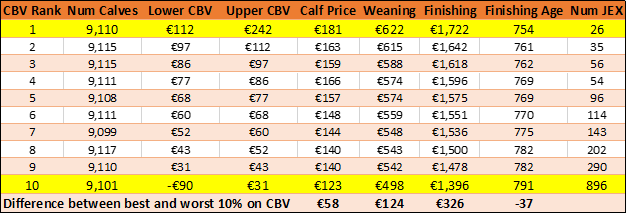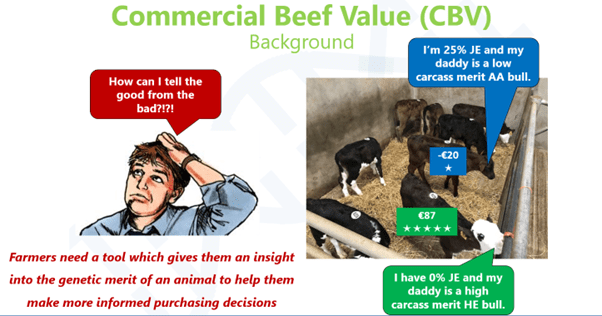One of the many benefits of the National Genotyping Programme will be the presence of CBV’s on martboards next spring for calves. The introduction of the CBV is an important development in the trading of beef animals. Whether it be dairy male calves at 3 weeks old, or continental suckler steers at 18 months old, having genetic information to hand when making sale/purchase decisions is vital for farmers. The analysis has shown that the CBV is predicting animals that ultimately have higher carcass performance. Farmers can, therefore, incorporate the CBV into their sale/purchase decisions with confidence.
Once all the calves are healthy and bright how can a potential buyer identify the calves that will leave him the most profit? The Commercial Beef Value. Calves going through the mart ring next year from herds participating in NGP will get a star rating for CBV up on the mart board.
For example, if a farmer buys an Angus bull calf from a dairy cow that is 5 stars on CBV how much more profit will it leave?

If we look at the table you can see the calves that are ranked best on C.B.V cost on average €181 while the poorest calves on C.B.V cost €123 so there was just a €58 difference in the calf price, but when we follow these animals through to slaughter we see a considerable difference in carcass value of the best and worst calves.
The high C.B.V calves had an average Carcass price of €1,722 while the lowest C.B.V calves had an average carcass price of €1,396. This represents a considerable difference in the carcass price of €326 between the best and worst C.B.V animals which is an awful lot of money when you consider the tight margins in beef finishing.
Another key positive to highlight from Table 1 is the finishing age, not only did the high C.B.V Angus Males have a better carcass price but they were also finished on average 37 days earlier then the low C.B.V animals. This represents a considerable saving in feed costs as the High C.B.V animals were fed for a month less which could save a farmer in the region of €185 on feed costs which is a significant saving per animal.
The other area to consider here also is the environmental impact of being able to finish these animals at a younger age, these animals are consuming considerably less feed as well as producing less emissions over their lifetime.
For more information on the CBV, please contact the HerdPlus office on 023-8820452 or email [email protected].

